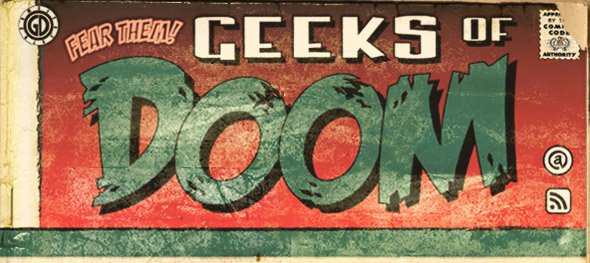
Doctor Who
Season 9, Episode 1 “The Magician’s Apprentice”
Directed by Hettie MacDonald
Written by Steven Moffat
Starring Peter Capaldi, Jenna Coleman, Michelle Gomez
BBC America
Air date: Saturday, September 19, 2015
This is what happens when narratives attack. In 1963, a 4-week-old BBC television show called Doctor Who embarks on its second serial by visiting the world of Skaro and introducing the semi-robotic survivors of an atomic war called the Daleks. The Daleks are a huge hit, establish the format of the show, and make it a fixture on British television for decades. The Daleks re-appear on the show every couple years. In 1975, the show finally decides to expose the origin of the Daleks. The Doctor returns to Skaro, sent by the Time Lords to prevent or alter their development. In it, viewers are introduced to Davros, the evil scientist extraordinaire who is fundamentally responsible for their development. The serial is considered to be one of the best Doctor Who stories ever. In 1988, Doctor Who revisits the time and place of its first episode from nearly 25 years earlier. Davros is there, leading one of two factions of Daleks, both of whom are after a stellar manipulator called the Hand of Omega. An ancient Time Lord artifact of tremendous power, the Doctor brought it to Earth and eventually uses it to destroy Skaro. This installment strongly signals a creative return to form for the series after years of poor creative choices, changes in time slot, and alterations in format. It is too late. Just short of two seasons later, Doctor Who is cancelled. In 2015, the ninth season of a revived Doctor Who series begins with the Doctor either saving or killing a young boy named Davros who’s trapped in a minefield on Skaro … what does it mean for Doctor Who this time? Let’s find out.
Here is what we know about the Steven Moffat era of the Doctor Who over four years in: head writer and showrunner Moffat is a man constantly bubbling-over with ideas. Many of those ideas are interesting and he is not afraid to put a lot of them on the air. So, you want trap a young boy in a field of weaponized hands with eyes in the palms to open your episode? Moffat says “sure” (and offers significant applause for director Hettie MacDonald’s staging of the sequence.) You want to name that boy Davros, a moniker that generations of Doctor Who fans will recognize? Moffat says “even better!” You want to give the Doctor the responsibility of deciding if that boy lives or dies? Moffat says “better still!” You want explicitly tie these events back to a famous speech made by Tom Baker’s Doctor in the story that introduced Davros in 1975? Moffat says “amazing!” and to some degree it is.
Where things start to fall apart in Episode 9.1 “The Magician’s Apprentice” is in the barrage of other either visually compelling or intellectually intriguing ideas. We see the Doctor entering an arena in 12th century Essex riding on the front of a 21st century tank playing an electric guitar. We see Clara stop teaching at Coal Hill School, get called to UNIT HQ by Kate Stewart in the Tower of London, and then flying off to the Continent to meet with Missy in some Mediterranean square. We get Colony Sarff, an apparent humanoid who glides like he’s on roller skates, but who is actually a colony of snakes. We get an Emperor Dalek presiding over a group of Daleks from every era of the last 50 years of shows. We get the destruction of Missy, Clara, and the TARDIS. It all comes so fast and furious that it causes continuity fatigue; every element of the show can be anything at any moment, leaving the viewer questioning the meaning of the assembled parts.
It wasn’t always this way. Though the Russell T. Davies revival of Doctor Who was not without its flaws, the series was careful in how it doled out its ideas to viewers. The spaces in between those ideas were filled with character continuity. This created some notion of crafted character story arcs. It also created a hit TV show. The big payoff for all that work came with the Season 4 two-part finale “The Stolen Earth”/”Journey’s End.” There, the viewer suddenly discovers that secondary ideas from the previous four seasons were Easter Eggs that piece together into a puzzle whose existence no one quite suspected.
Steven Moffat worked very well as a writer for the Davies-era show. As a man of ideas, he contributed several episodes that are counted as among that era’s best. In “The Empty Child”/”The Doctor Dances,” the Doctor and Rose find themselves in the London Blitz opposing a cloud of nano-machines who mistakenly think that human faces should be part gas mask. Along the way, we get Jack Harkness, who in Davies’ hands eventually leads the spin-off series Torchwood. In Season 2, Moffat gave us “The Girl In The Fireplace,” a marvelous fantasy with time travel and clockwork robots set in both the distant future and ancient regime France. In Season 3, we get “Blink” and the introduction of the Weeping Angels, one of the major (if not the most important) new monsters of the revived series. Finally, Season 4 gives us River Song for the first time (to us and the Doctor) and the last time (to her) in “Silence In The Library”/”The Forest of the Dead.” Moffat’s ideas within the Davies framework of the series are positively stellar. Without that framework, however, those ideas just come too many at a time and too fast.
After writing all that, I don’t want to make “The Magician’s Apprentice” sound lousy, because it isn’t. It’s just not as well realized as it could be. As I point out at the beginning, it is the latest in a series of narrative attacks and counter-attacks between the Doctor and the Daleks that have been going on for over 50 years. The Daleks are Doctor Who to a significant degree. The Doctor was written into the Daleks’ past in 1975, and they were written into the Doctor’s past in 1988, both to great creative effect. To then boldly take that a step further by writing a much later Doctor into the origin of Davros, the creator of the Daleks, is a positively inspired idea.
It cuts at the heart of a question raised in 1975 and quoted during this new episode:
Listen, if someone who knew the future, pointed out a child to you and told you that child would grow up to be totally evil, to be a ruthless dictator who would destroy millions of lives, could you then kill that child?
Tom Baker’s Doctor firmly answered “no” to the question, closing the serial with these words:
You see, I know that while the Daleks will cause havoc and destruction for millions of years, I know also that out of their evil must come something good.
The answer here is more of an open question that has real narrative weight, in part because of the tone set at the beginning of last season. There, we saw the Doctor somewhat uncharacteristically pour himself a drink and say “I believe I may have to kill you” – an act and a statement seemingly uncharacteristic of many of the other versions of the Doctor in the last 50 years. Russell T. Davies has said in interviews that the important thing to him rebooting the series was to give mystery back to the Doctor after so many stories had been told. Now, Steven Moffat and Peter Capaldi don’t care about that mystery in the origin sense, but they do want to give the title character more of the moral ambiguity that William Hartnell had at the start.
The ideas surrounding the conflict are in so many ways equally inspired. Where the Doctor’s home planet Gallifrey is placed in a pocket universe in “The Day Of The Doctor,” the Daleks’ home planet Skaro is rendered almost completely invisible to further underline their equality in the narrative conflict. At the same time, the Doctor chooses to give his last will and testament to Missy, bringing her into the story with something of a role reversal but in way that does nothing to compromise that character’s integrity.
About the only one who suffers in all of this is Clara. She is teaching at Coal Hill School one minute, functioning as a central part of UNIT in the Tower of London the next, and then traveling to far off times and places shortly thereafter. At this point, who is she really? Jenna Coleman has played three different versions of the character, and jumped into and out of the Doctor’s entire life stream. She’s led a double life. She’s left the show, and then changed her mind. It’s getting to be a bit much. Perhaps it’s just for the best that she is leaving after this season.
I’m sure I will be revisiting questions of creative fatigue for Clara, Steven Moffat, and the rest of the show as the season unfolds over the next eleven episodes. This season premiere gets high marks for narrative weight, some inspired staging and visuals from director Hettie MacDonald, and bold performances from all the principals. The weaknesses of the episode points more toward structural problems in the show’s production style in recent years. Will that style persist beyond this season? I guess we’ll see. Part of me hopes it will, part hopes it won’t.






No Comments »
No comments yet.
RSS feed for comments on this post. TrackBack URL
Leave a comment